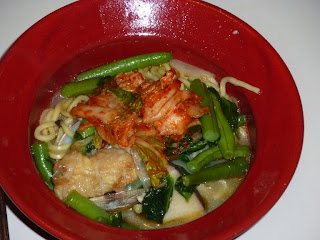
The one advantage of having a late harvest is that I still have some free time on my hands, weekends are basically a foreign concept once harvest actually kicks in. This past weekend I headed up to Portland to visit a friend and check out some of the local breweries. On the way back, I stopped in the bustling metropolis of Tigard because there is a large Asian supermarket there and I had to get something for dinner.
Asian supermarkets are one of my favorites to visit because there's still a bit of adventure and mystery for me. I'm pretty well versed with ingredients from around the world and I'm rarely at a loss for what to do with them. However, I still find myself ocassionally standing in front of jars, vials and boxes of delectable foodstuffs with descriptions in languages I have no chance of understanding (my romance languages won't work here) and feeling overwhelmed. For me, it takes me back to the period when I was first falling in love with cooking. I usually end up buying random bottles and vibrant produce that catch my eye and then just experimenting.
This instance was merely a brief stop. I was hitching a ride and since I have a bad habit of spending hours in grocery stores, I was going in focused. I got home with a small selection of treats and expectation at my next chance to explore and properly shop.
I was in the mood for seafood and the market had the full array of fresh mollusks, crustaceans and fish. I decided on some clams and a fillet of cod. A quick seafood stew sounded like the best way to cap off a day of drinking beer.
I apologize in advance for issues with the recipes. I've never been great about constructing recipes because I rarely use exact measurements myself, for me it's all about tasting as you go and using your instincts.
Seafood Stew
One pound of clams (small-medium sized), cleaned and debearded
One half pound of cod or other firm-fleshed white fish, cut in to 2-3 inch pieces
One quarter pound ham, cubed
Two shallots, sliced finely
One quarter pound oyster mushroom, sliced
One half pound of green beans, cut in half
One teaspoon of sambal, or other chili paste
Two cups of stock (fish or chicken)
A splash of fish sauce
The juice of half a lime
Diced cilantro for garnish
Add a splash of oil and cook the ham until the edges are beginning to carmelize and it has rendered some juices/ fat (if you use bacon or pancetta you won't need to add extra oil). Add the shallots and a pinch of salt and cook until they are softened and lighly browned. Add the oyster mushrooms and cook for another few minutes. Add in the sambal (more or less than called for depending on your love of spice) and allow it to toast for 10-15 seconds. Add the stock, fish sauce and a cup of water and bring up to a boil. Reduce the heat to medium and add the green beans and lightly season the pot with salt.
In a separate pan add oil and over medium-high heat brown the pieces of cod. If you want more of a crispy, fried quality to your fish you can dredge them in flour. This time I just seasoned with salt and pepper.
After about five to seven minutes check the green beans. They should have a little crunch still, but be almost cooked. Bring the heat back up and add the clams, cover your pot. The clams should open up in about five minutes. After about three minutes, gently nestle the fish pieces in and cover. Once the clams have opened, remove from heat and add the lime juice and cilantro and salt to taste.
The quality of the photo is not great and I didn't really have the patience to try to get a perfect one as I was a bit peckish. The lighting isn't great in Stermer house and food photography is unreasonably difficult. Who knew it would be so hard to make something look as good as it does in real life?
Until the next time...
 This is my commute everyday. I get to walk down the hill from Stermer Vineyard to the winery. It normally takes a grand total of four minutes, depending on how motivated I feel.
This is my commute everyday. I get to walk down the hill from Stermer Vineyard to the winery. It normally takes a grand total of four minutes, depending on how motivated I feel.





